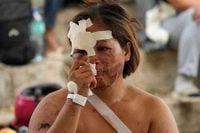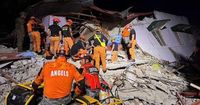When the ground began to shake just before 10 p.m. on September 30, 2025, in the central Philippines, most residents of Bogo City and the surrounding towns in Cebu province were at home, some already asleep. Within moments, a magnitude 6.9 earthquake—its epicenter just off the coast and only five kilometers below the surface—sent shockwaves through the region, toppling buildings, cracking bridges, and turning vibrant neighborhoods into scenes of devastation.
The Philippines, perched on the volatile Pacific Ring of Fire, is no stranger to seismic activity. But this quake, as reported by the Philippine Institute of Volcanology and Seismology, was the deadliest since 2013, when a 7.2-magnitude tremor struck neighboring Bohol island, claiming more than 200 lives. According to BBC, the latest disaster left at least 72 dead and more than 500 injured, with the toll expected to climb as rescue operations continued through the week.
Rescuers raced against time, using backhoes, sniffer dogs, and even their bare hands to search for survivors trapped beneath the rubble. In Bogo City, disaster-mitigation officer Rex Ygot described the harrowing efforts to reach those buried in collapsed shanties and mountain villages struck by landslides. "It’s hard to move in the area because there are hazards," his colleague Glenn Ursal told The Associated Press. The quake’s timing—striking late at night—made it especially deadly. As civil defense official Bernardo Rafaelito Alejandro IV explained in a Manila news conference, "In the morning, we are all alert, but at night when everyone is asleep, it takes time for us to react."
The scale of destruction quickly became clear. Buildings, including a century-old church, crumbled. Part of a sports complex collapsed on spectators during a basketball game. In Bogo City, a village built for survivors of 2013’s Super Typhoon Haiyan—supposedly with “disaster resilient homes”—reported about 10 casualties. Outlying towns like Medellin and San Remigio also suffered losses, among them three coast guard personnel, a firefighter, and a child, all killed by collapsing walls or falling debris as they tried to escape the chaos.
For many survivors, the nightmare did not end when the trembling stopped. Aftershocks—more than 600 detected by October 2, according to Philippine Institute of Volcanology and Seismology director Teresito Bacolcol—kept nerves on edge. Thousands chose to sleep outdoors in fields and parks, despite sporadic rain, too afraid to return to damaged homes. Arguel Estalicas, a tourism officer from Medellin, told BBC, "I still couldn't process what has happened to us. I am overwhelmed with the things we experienced in the last two days." She described how her family, lacking raincoats, huddled in plastic bags beneath the open sky, their breath fogging up the makeshift shelter.
In San Remigio, community journalist Lourenze Pareja livestreamed the panic as neighbors in pajamas fled their homes with children and pets. "What was once a vibrant city has turned into a ghost town," he recounted. The scenes in Bogo City were equally grim: body bags lined up outside makeshift hospitals, while rows of white coffins awaited mourners under tents.
The disaster struck a region already battered by nature’s fury. Just days earlier, a tropical storm had swept through Cebu and nearby provinces, leaving at least 27 dead, knocking out power to entire cities, and forcing tens of thousands to evacuate. The storm’s heavy rains soaked hillsides, heightening the risk of landslides when the earthquake hit. As Bacolcol noted, "Rain-soaked mountainsides were more susceptible to land- and mudslides in a major earthquake." The compounded disasters left over 170,000 people affected by the quake, with nearly 80,000 displaced, according to disaster response officials cited by BBC and 1News.
Recovery was slow and fraught with challenges. Roads were blocked by debris, bridges cracked, and power outages hampered rescue and relief efforts. Photographer Doods Demape described to BBC his four-hour journey from Medellin to the provincial capital in search of food and water. "Most roads are now passable so supplies are now coming in from the city. But immediate supplies like water and food, especially for the children, are not yet available," he said, noting long queues at petrol stations and shuttered supermarkets.
The government responded swiftly, declaring a state of calamity in Cebu province on October 1. President Ferdinand "Bongbong" Marcos Jr. visited hard-hit areas the following day, assessing damage and promising support. The Philippine military deployed troops to help maintain order and assist with relief efforts, while schools and government offices in affected towns remained closed as building safety was assessed. The government also considered seeking foreign assistance, pending a rapid damage assessment.
Meanwhile, the emotional toll was plain to see. Survivors like Estalicas reported dizziness and trauma, with many too frightened to re-enter their homes due to the persistent aftershocks. Bacolcol summed up the mood: "This was really traumatic to people. They’ve been lashed by a storm then jolted by an earthquake. I don’t want to experience what they’ve gone through."
Despite the devastation, stories of resilience and community spirit—what Filipinos call bayanihan—emerged. Pareja, reflecting on the hardships, said, "My only prayer is that help won't be delayed—and that neighboring municipalities will also be considered and covered in these relief efforts." Locals banded together, sharing what little they had and supporting each other through the crisis, just as they had during previous calamities like Super Typhoon Haiyan in 2013, which killed over 6,000 in the region.
This latest disaster has reignited concerns about the country’s vulnerability to natural hazards. With more than 20 typhoons and tropical storms each year, and a history of deadly quakes, the Philippines faces an uphill battle in disaster preparedness. The recent quake has also prompted renewed fears over the so-called "Big One"—a potential magnitude 7.2 earthquake predicted for Manila, which could cause catastrophic damage and tens of thousands of deaths. As Alejandro warned, "We can never be 100% prepared. Events like this [earthquake], for us also, is one way of practice. Can you imagine if it happens in Metro Manila at night?"
For now, the people of Cebu and the central Philippines are left to pick up the pieces, drawing on faith, hope, and the enduring strength of community as they face the long road to recovery.


